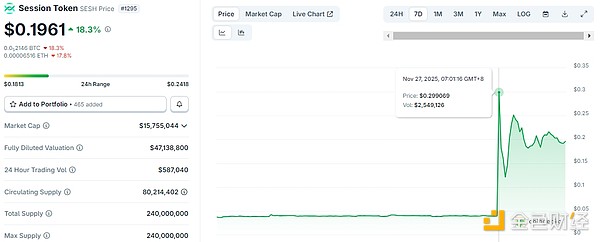XRP News Today: Regulators and Institutions Quietly Fuel XRP's October Breakout
- XRP gains traction as SEC rulings on ETFs (Oct 18-19) and regulatory clarity post-2025 lawsuit resolution boost investor confidence. - CME XRP futures open interest exceeds $1B, while $2.96 price and $176B market cap solidify top-3 crypto status amid volatility. - RippleNet's 90+ markets and 60+ firms building XRP reserves mirror Bitcoin's treasury adoption, expanding utility in cross-border payments. - 2025 RLUSD stablecoin launch and 10+ ETF applications signal institutional acceptance, though stableco
XRP, the native token of the XRP Ledger (XRPL), has recently seen a resurgence in investor interest amid regulatory and institutional developments. Analyst Keith Noonan, a prominent figure in the crypto space, has urged investors to consider XRP ahead of October, citing potential catalysts such as the U.S. Securities and Exchange Commission's (SEC) upcoming decision on XRP-focused ETFs. The Grayscale XRP Trust and the 21Shares Core XRP Trust are set for rulings on October 18 and 19, respectively, which could significantly influence XRP's market dynamics. Despite lingering regulatory uncertainties, the shift in the SEC’s stance under current chairman Paul Atkins—favoring a more accommodating approach to crypto—has been interpreted as a positive sign for XRP’s prospects [1].
XRP’s technical metrics also show promising trends. Open interest in XRP futures on the Chicago Mercantile Exchange (CME) has surged past $1 billion in less than four months, reflecting heightened institutional participation and growing market maturity. This increase suggests that XRP is gaining traction as a viable asset for both speculative and utility-driven purposes [1]. Additionally, XRP’s current price near $2.96 and a market cap of approximately $176 billion position it among the top three cryptocurrencies, demonstrating its resilience and appeal in a volatile market environment [2].
Looking ahead, XRP’s long-term value will largely depend on its ability to expand its real-world utility. Ripple’s cross-border payment network, RippleNet, already serves over 90 markets and 55 currencies, offering institutions a cost-effective and fast alternative to traditional financial systems. The integration of XRP into these corridors could further solidify its role in global remittances, particularly in high-cost regions like Asia and Africa. Notably, companies such as SBI Remit and Onafriq have already begun leveraging XRP for real-time cross-border transactions, signaling a shift toward utility-driven adoption [2]. Analysts project that if these trends continue, XRP could see significant price appreciation by 2030, with some forecasts suggesting a potential rise to around $5.25 [2].
Regulatory clarity has also played a crucial role in XRP’s recent momentum. The resolution of the long-standing SEC vs. Ripple case in August 2025 provided much-needed legal certainty, removing a key overhang that had previously hindered institutional adoption. This development has not only restored investor confidence but also paved the way for new financial products, including spot ETFs. As of July 2025, at least ten firms have filed for XRP ETF approvals, with decisions expected in October. The approval of these products could create a new demand channel from both retail and institutional investors, potentially driving further price increases [2].
Institutional adoption remains a key driver of XRP’s future. Over 60 companies, including SBI and Trident , have either filed or announced plans to create XRP reserves, a strategy that goes beyond mere speculation and integrates XRP into corporate financial infrastructure. This trend mirrors early Bitcoin treasury strategies but is more focused on payments and utility. Additionally, the launch of Ripple’s RLUSD stablecoin in 2025, backed by reserves custodied with Bank of New York Mellon , has opened new avenues for institutional onboarding through regulated, dollar-denominated assets [4]. These moves indicate a broader acceptance of XRP in traditional finance and suggest that its role as a bridge asset may continue to expand.
While XRP’s prospects are optimistic, challenges remain. Competition from stablecoins and central bank digital currencies (CBDCs) could limit XRP’s utility in certain corridors, particularly where low volatility is preferred. Execution risks, such as early technical issues with the XRP Ledger’s automated market maker (AMM), also pose potential hurdles to its widespread adoption [2]. However, with continued improvements in liquidity and regulatory support, XRP is well-positioned to navigate these challenges and emerge as a leading digital asset in the years ahead.
Source:

Disclaimer: The content of this article solely reflects the author's opinion and does not represent the platform in any capacity. This article is not intended to serve as a reference for making investment decisions.
You may also like
Bitcoin security reaches a historic high, but miner revenue drops to a historic low. Where will mining companies find new sources of income?
The current paradox of the Bitcoin network is particularly striking: while the protocol layer has never been more secure due to high hash power, the underlying mining industry is facing pressure from capital liquidation and consolidation.

What are the privacy messaging apps Session and SimpleX donated by Vitalik?
Why did Vitalik take action? From content encryption to metadata privacy.

The covert war escalates: Hyperliquid faces a "kamikaze" attack, but the real battle may have just begun
The attacker incurred a loss of 3 million in a "suicidal" attack, but may have achieved breakeven through external hedging. This appears more like a low-cost "stress test" targeting the protocol's defensive capabilities.

